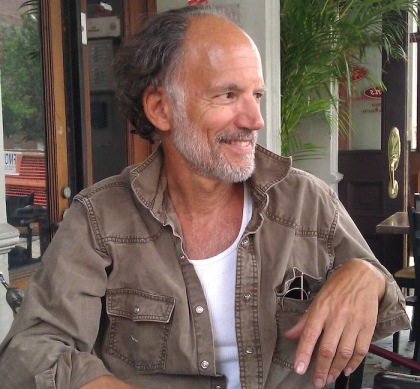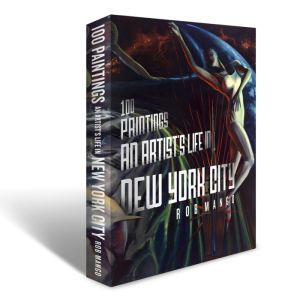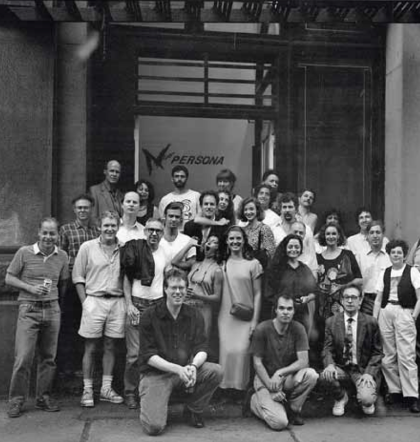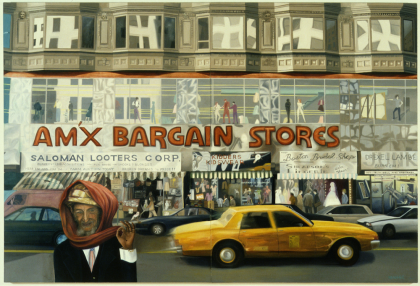Rob Mango on Opening a Tribeca Gallery in 1984

 When I learned that artist Rob Mango—whose gallery on Duane Park is a Tribeca institution—had a new book, 100 Paintings: An Artist’s Life in New York City, I assumed it was focused on his art. But it’s so much more: a memoir about his own life, and a vivid account of the birth of Tribeca as a residential neighborhood. He agreed to let me run several excerpts, along with the corresponding paintings. The book is available at Rob’s gallery at 178 Duane as well as robertmango.com, Amazon, and Barnes & Noble.
When I learned that artist Rob Mango—whose gallery on Duane Park is a Tribeca institution—had a new book, 100 Paintings: An Artist’s Life in New York City, I assumed it was focused on his art. But it’s so much more: a memoir about his own life, and a vivid account of the birth of Tribeca as a residential neighborhood. He agreed to let me run several excerpts, along with the corresponding paintings. The book is available at Rob’s gallery at 178 Duane as well as robertmango.com, Amazon, and Barnes & Noble.
Previously in this series:
••• Artist Rob Mango on Tribeca’s Pioneer Days
••• Rob Mango on Tribeca Becoming Tribeca
••• When Hollywood Royalty Came to Visit
I opened my gallery, Neo Persona, in 1984. Opening a gallery was something I’d been thinking about since college. I was raised by my father to be independent, and as an athlete, I’d honed a can-do mentality. Gallery relationships in NYC seem to require an artist to be needy, which was anathema to me. I recoiled at any vestige of weakness in myself and was wary of anything resembling self-pity. In general, my patrons—the Wall Street bunch—were cut from the same cloth.
Suddenly, I was hanging out with investment bankers from Salomon Brothers, Shearson Lehman, Kidder Peabody, Drexel Burnham Lambert and others. I didn’t exactly enjoy downing light beer, playing liar’s poker, and betting on NFL football on Sunday afternoons, but they did—so I hung out and played anyway. I was soliciting business, but I was also making friends. The best of these guys were either former college athletes or math whizzes turned risk-management pros. They viewed the rise and fall of an investment instrument and choosing the winner of a pro sports contest as possessing exactly the same over/under dynamic. My art began to reflect my new world: During that decade of mergers and acquisitions, several investment houses either disappeared or melded into one other. I painted a satire, Merger in the Wings, depicting an instantly recognizable shopping strip on 14th Street.
Like the first generation of artists in Tribeca, the first wave of building owners had more of a sense of adventure and less a sense of entitlement. Already a rising star in the Manhattan rental housing business, Norman H. Segal was fascinated by the possibilities of Tribeca real estate. Previously, he’d been the first serious developer to buy a bombed-out vacant lot in Harlem and build new middle-income housing. Noble, virtuous and courageous, he was pictured on the front page of The New York Times for his civic improvements. His true love, however, was the arts.
Though Soho was the center of the art scene in the ’80s, many of the best artists in New York City lived in Tribeca and were my good friends. One fine day Norman suggested we open a gallery for these artists. The notion that it would focus on Tribeca as its talent base happened quite naturally, and Neo Persona Gallery was born. I had the backer and the artists, including myself. The next thing needed was an affordable location.
I spoke with my friend Jeff Lamb about a currently vacant storefront at 165 Duane Street (at the corner of Hudson Street). Jeff was its developer and owned the stores. This was the same building where I had been nightwatchman and superintendent the year before and the building where Martin Scorsese owned three units. I struck a deal with Jeff, the lease was prepared, and Norman and I cosigned it.
The premises had been empty for some time and needed a complete demolition and renovation, including walls, floors, offices and lighting. I had a clear idea of what I wanted and did most of the work myself. When my artist buddies dropped by, they could sense the potential. And the gallery looked great: 2,700 square feet of polished floors, high ceilings and pendant lighting. We were ready in six weeks.
 Our robust opening group show was in September 1984. Our aesthetic would be a balance: edgy enough to impress the art community but accessible enough in price and style to attract the new loft buyers in the neighborhood. The first several seasons we gave solo exhibitions to Willy Lenski, Richard Wood, Charles Yoder, Ruth Kligman (Jackson Pollock’s infamous mistress), Jean Holabird, Ralph Gionta, Chris Britz, Joe Andoe, Jake Grossberg, Burt Hasen, Nikko Sedgwick, Robert Witz and myself. The openings were extremely social events crowded with an ever-multiplying array of friends and a complex line-up of artists, their admirers, the occasional art critic, and my assiduously assembled collectorship. Unlike many galleries, I provided beer, wine and food for the artists before the show opened! This was Norman Segal’s idea: He believed artists needed a free meal whenever possible, and Neo Persona was an “artists’ gallery.”
Our robust opening group show was in September 1984. Our aesthetic would be a balance: edgy enough to impress the art community but accessible enough in price and style to attract the new loft buyers in the neighborhood. The first several seasons we gave solo exhibitions to Willy Lenski, Richard Wood, Charles Yoder, Ruth Kligman (Jackson Pollock’s infamous mistress), Jean Holabird, Ralph Gionta, Chris Britz, Joe Andoe, Jake Grossberg, Burt Hasen, Nikko Sedgwick, Robert Witz and myself. The openings were extremely social events crowded with an ever-multiplying array of friends and a complex line-up of artists, their admirers, the occasional art critic, and my assiduously assembled collectorship. Unlike many galleries, I provided beer, wine and food for the artists before the show opened! This was Norman Segal’s idea: He believed artists needed a free meal whenever possible, and Neo Persona was an “artists’ gallery.”
Openings were critically important as opportunities for the collectors—snazzy professionals—to mix with the gritty downtown artists and their followers. And I realized it was imperative to initiate or seize sales opportunities in the midst of opening night exuberance. Stated interest or simple curiosity about a given artist or painting could evolve into a purchase, or be simply blather. I found threading the spoken interest into the needle of a sale was best accomplished socially. Expensive dinners and private events at Tribeca’s finest establishments—Le Zinc, Odeon and Bouley—became part of my weekly schedule. It gave me an opportunity to do what I love—talk about art and praise artists.
Andy Warhol was a master entrepreneur/artist. I had observed him hanging at the Odeon with Jean Michel Basquiat and Julian Schnabel. I met Andy at the bar and we chatted at length one evening. He knew of my gallery. Andy was self-deprecating and had an uncanny knack for getting you to do most of the talking, but I remember one thing he said: “The wife always makes the decisions when buying art. The husband doesn’t matter very much. They work it out in bed. She gets what she wants after providing what he wants.”
In 1992, I closed Neo Persona Gallery. The lease was up, and Hudson Street was slated to be torn up and re-piped by the City of New York Department of Public Works. Our location would experience a crippling deprivation of street traffic and general access. More than this, though, I needed more studio time.














